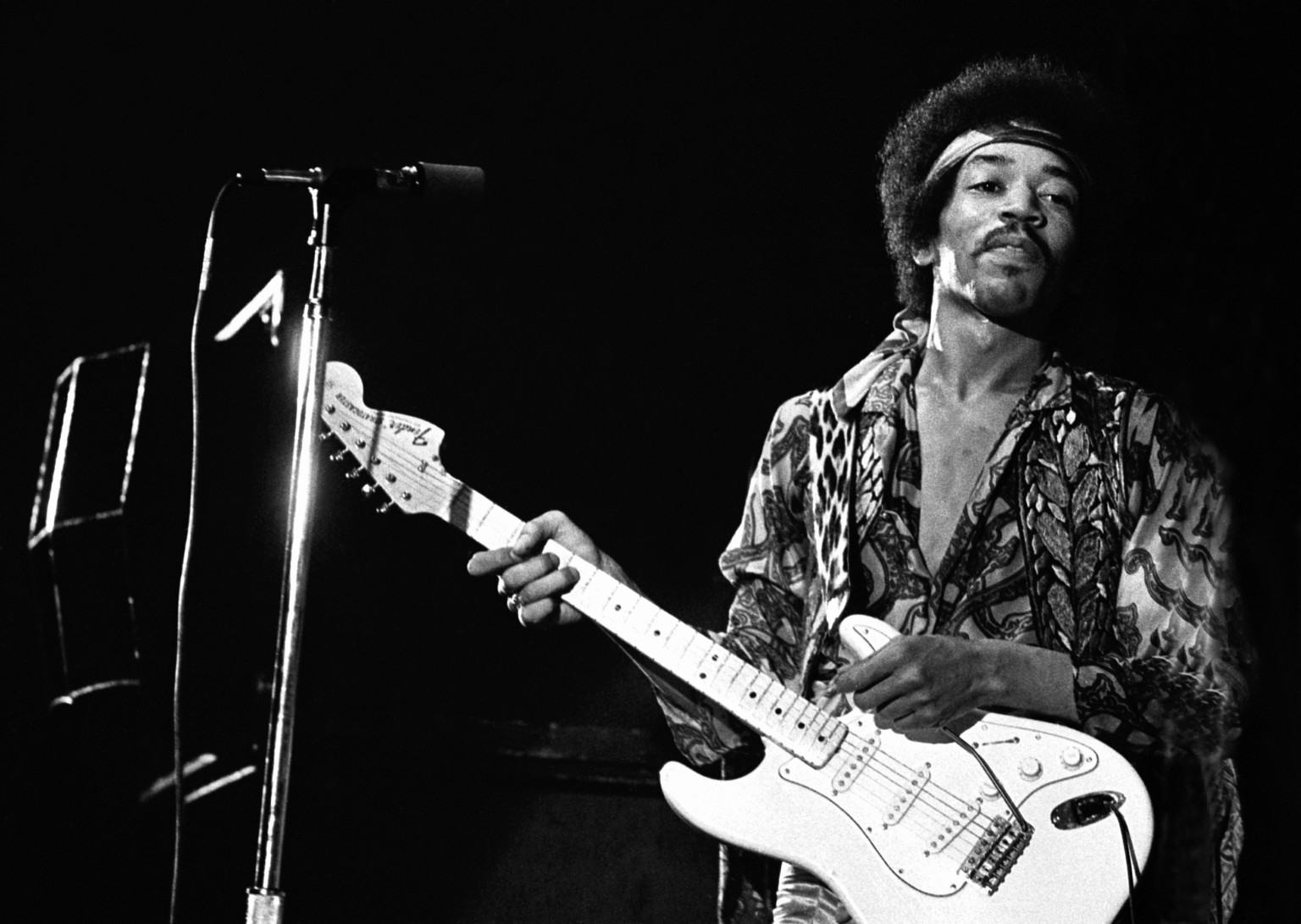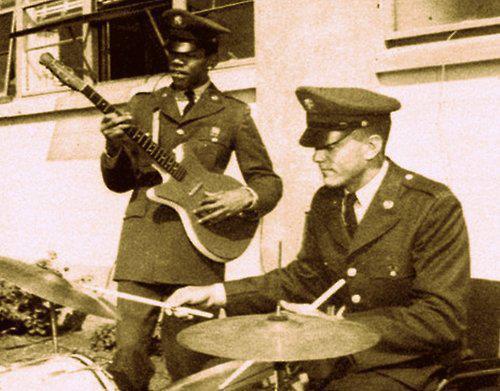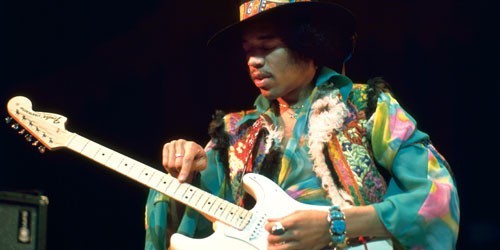Jimi Hendrix Guitar Setup And Rig Rundown
by Jay Sandwich
Ever since electric guitars were first invented back in the ’50s, there have been hundreds of guitar players who have all been considered to be the masters of their art.
However, there is one man who probably isn’t the most technically proficient guitar player who ever lived, but that one man is considered to be the best guitar player who ever walked the earth.
The one that is at the top of every internet list all the time, and rightfully so as his playing has influenced players of all genres from jazz, blues, and all the way to the heaviest of metals.
If you haven’t guessed it by now, we are talking about none other than Jimi Hendrix. Cue awesome and rare Hendrix solo…
There are numerous reasons why we make this claim along with thousands of other music critics.
His way of handling electric guitar was simply unique at the time. He was a lefty, but he insisted on playing a right-handed guitar turned upside down. This seemingly inconvenient method of playing allowed him to have a pretty distinctive sound and approach to his left and right hand techniques.
That sound combined with his own take on standard blues boxes is what made him one of the elite, one of the best guitarists in the history of rock music.
Even to this day, you’ll hear people praising his songwriting, guitar playing, and arrangement skills. Hendrix pretty much set the standard for all the musicians that came after him.
In this article here, we are going to go over the gear he used during his career and talk about the technical aspect of his style.

| Fender Jimi Hendrix Stratocaster – Olympic White |
|---|
| Supro S6420+ Thunderbolt Plus 1X15″ Combo Guitar Amp |
| Dunlop Jimi Hendrix Fuzz Face Distortion |
| Roger Mayer Octavia Rocket Series – Octave Effect Pedal |
Guitars
The most obvious thing anyone watching Jimi Hendrix perform for the first time would notice, are his guitars.
As we have mentioned before, he always used the right-handed models which he played inverted.
Not only did he achieve a unique tone that way, but the whole performance looked completely amazing as well.
Those who have spent some time going over the footage of his live shows and you have probably noticed that he almost exclusively used a Fender Stratocaster.
That is true for the most part. However, he used a variety of other guitars. Let’s go over some of the most notable models in his collection.
Believe it or not, Jimi’s metaphorical guitar rack was full of a variety of guitar models, some of whom were not often seen in his hands.
We will get to his Stratocasters a bit later. For now, let us start with his very first electric guitar. The model in question is a very elusive 1957 Supro Ozark 1560s.
This was a pretty cheap and rather unusual electric guitar which was gifted to Jimi by his father back in 1959.
As fate would have it, Hendrix only got to play this guitar for a year or so before it was stolen after one of his early performances. This one was made by a now mostly forgotten company named Valco.
The model itself is somewhat of a collectible item among the guitar enthusiasts, but just imagine how much it would sell for if someone was to dig up this Hendrix’s guitar and prove that it was, in fact, the one he played on.
Next guitar he got was a Danelectro Shorthorn 3012. This one was a replacement for the stolen guitar. It’s a simple instrument that was popular at the time, featuring one single-coil pickup.
There were some discussions over the years between the music historians whether this was a 2013 or a U-1 model, but it was later confirmed that this was, in fact, a 3012.

Later down the road, he got into Strats. But before that time, he owned an Epiphone, a Fender Duo-Sonic, Fender Jazzmasters, and even an old Ibanez called Jet King 2 which was pretty much a Jazzmaster copy.
The Epiphone in question was the 1961 Wilshire, and he used this particular instrument while performing with a band called King Casuals, sometime in the early 1960s.
His Strats start out with the 1964 model he got in New York City circa 1966. And that was the moment he fell in love with this specific model. The guitar was white with a rosewood fretboard, which is something Hendrix would go on to abandon completely later on in his career.
His 1965 Strat is among the more notable guitars he ever played simply because it was the first one he burned during one of his performances. This unusual practice would become his signature thing.
Check out PlayRockZone kicking out some Little Wing. Hear that sound?
However, the most important guitar to ever be played by Jimi Hendrix is the 1968 Fender Stratocaster.
This was Jimi’s favorite guitar, and the one he played the most. It was a black Strat with a maple fretboard. Its been said that he played this very Strat the night of his death. Current whereabouts of this Strat, unfortunately, still remain a mystery.
Check out EddieVegas in this video showing off the ’68 Strat.
Aside from these, Hendrix was seen holding some other guitars at the hight of his career. There was a Bartell Black Widow, a semi-hollow body guitar that isn’t that easy to find these days. He traded it for one of the Stratocasters.
Although a Fender guy, it wasn’t that unusual for Hendrix to be seen holding an instrument made by Gibson, their biggest competitors. He owned a few Les Pauls, the most notable one was a right-handed black ’56 Custom. This one is currently owned by Hard Rock Cafe International.
Hendrix also owned two Gibson Flying V guitars. One of those is a hand-painted Flying V that Gibson even revived as a very expensive Custom Shop version in the 2000s.
Among other Gibsons, there were a few SGs in his collection. This does not come as a surprise as the SG’s design had some advantages for left-handed players who had troubles finding instruments they could use properly.
There was a white 1967 Custom Shop SG that he used over the years. This guitar is also currently owned by Hard Rock Caffe.
Amps
In terms of amps, Hendrix was a pretty straightforward type of guy. During his early days, he was very much involved with Silvertone Twin Twelves, Supro Thunderbolts, and finally the legendary Fender Twin Reverb.
Later on in his career, Hendrix became a huge Marshall fan.
Take a look at this Silvertone 1484 Twin Twelve, with playing courtesy of Rocket Music.
And here is ProGuitarShop Demos with a demo of the Supro S6420+ Thunderbolt. Behold!
He went through a huge number of Marshall Plexis which included a variety of models. Among the most notable Plexi amps, we could find is the JTM45 and 1959 Super Lead.
The Super Lead is a legendary amp, also used by many other guitar heroes of the ’60s and the ’70s. Both of these amps have that trademark vintage Marshall tone which many guitar players around the world still love to this day.
Hendrix really knew how to push those tubes to the point of breaking, which did happen more than several times during his performances.
Here’s Guitar Gear Demos with a great demo of the Marshall JTM45 1965 Plexi Vintage ORIGINAL Guitar Amp!
And here’s Brigado70 playing the Marshall 1959 Super Lead with his Gibson Les Paul..
There have been some more “obscure” amp models in his arsenal that are definitely worth mentioning. One of those is an Ampeg Portaflex, the B15-N model.
And there were also some Sunn amps in there as well, like the 100s. He even made a deal with the company to provide his band with equipment after the legendary Monterey Pop Festival.
Effects Pedals
Effects pedals are not something Hendrix is known for too widely. Which is not really a surprise since the 1960s was not exactly the era of guitar pedals and not that many of them were widely used back in those days.
All in all, there are few pedals that he implemented, with two of those being different Vox wah pedals. Wah-wah, of course, became one of the most important effects in his rig, something he even became very well-known for.
With that said, he did love one single pedal which he based his whole tone upon. That is none other than the legendary Dallas Arbiter Fuzz Face.
Here’s Graemey demonstrating the power of the pedal.
Hendrix carried this thing with him just about everywhere he went. He is also one of the reasons why this particular pedal became so popular in later years.
Today, Fuzz Face is made by Dunlop and it represents a very true copy of the original one Hendrix used.
Back in the late 1960s, the Fuzz Face was made by Dallas Arbiter. The idea behind this peculiar design was for it to serve as a microphone stand. While it didn’t serve this function, it had a pretty great tone.
However, the very first series of Fuzz Face came with germanium transistors and were known for amazing tone. However, these were a bit unstable and tended to overheat, ultimately changing the tone mid-session. They were then replaced by the standard silicon transistors.
Of course, the robust and large casing would be kind of impractical these days, so Dunlop basically makes those mini versions of the Fuzz Face that nicely fit into any standard pedalboard out there.
There was another dirt box that he used, the Roger Mayer Octavia. This is an octave fuzz pedal, something that was popular at the time.
We should also not forget the legendary Univox Uni-Vibe pedal that delivered some of the best-known vibrato and chorus tones. Not to mention that it has also been seen in signal chains of many other guitar heroes throughout the decades.
Conclusion
Replicating Jimi’s sound is, seemingly, not too hard, especially with the abundance of equipment we have today and the fact that he kept everything simple. In some ways, you could definitely scale down his whole setup to a vintage Fender Stratocaster, a Marshall Plexi and a that Fuzz Face pedal.

However, those subtleties he was the master of – now, those are going to take a lot of skill and knowledge to get down correctly! The list of gear we showed you here represents the most important equipment he Hendrix used during his brief career.
You can start by using a Fender Stratocaster, or even a cheaper copy although quality single-coil pickups will help you out in the process. Many Marshall amps these days and various digital modelling units also have presets that will replicate Hendrix’s tone.
If you really want to go old school, an old vintage fender, Marshall Super Lead, and the Fuzz Face will help you out. In case that’s too expensive for you, you can go with a Mexican Strat, a small tube-driven Marshall, and any kind of a fuzz pedal.
You should also not forget about Hendrix’s extensive use of wah pedals and there are many products out there specially designed to help you copy his wah tones. However, even the standard Dunlop Cry Baby GCB95 can come in handy in this case.
In the end, replicating Jimi’s tone also takes a lot of practice. Even if you had the same exact instruments and amps, it’s not exactly easy to make it all sound like him.
It will take time, but closely listening to his dynamics, the way he picked the strings, his choice of notes, and all the other things will help you get there. This is all of huge importance if you’re trying to get it close to his tone.
His skill, tone and overall charisma drove millions of peoples for decades, and chances are he will have that same effect on fans of hard sound far into the future. The gear he used to achieve his impressive sound is nothing too special.
For the most part, it’s a somewhat standard combination of guitars and amps with a sprinkle of thick fuzz. The core of his characteristic tone lies within the way he played the guitar, how he made it scream.
 |
 |
 |
 |

About Jay Sandwich
Jay is an ex-shred guitar player and current modular synth noodler from a small town somewhere. Quote: “I’m a salty old sandwich with a perspective as fresh as bread.” No bull.
Leave a Reply
Musical Inspiration
Check for FREE Gifts. Or latest free acoustic guitars from our shop.
Remove Ad block to reveal all the rewards. Once done, hit a button below
 |
 |
 |
 |



